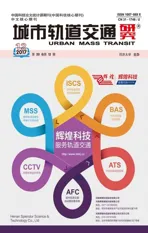城际铁路与市域铁路的模糊边界
2018-01-02孙章
孙 章
(同济大学《城市轨道交通研究》主编,教授)
城际铁路与市域铁路的模糊边界
孙 章
(同济大学《城市轨道交通研究》主编,教授)

我国的《“十三五”规划纲要》指出:在城镇化地区大力发展城际铁路、市域(郊)铁路,鼓励利用既有铁路开行城际列车,形成多层次轨道交通骨干网络,高效衔接大中小城市和城镇。“十三五”期间的城际铁路、市域铁路规划,对推进我国新型城镇化建设具有重要意义。
在客观世界中,普遍存在着大量的模糊现象。现代科技所面临的系统日益复杂,其模糊性也总会伴随着复杂性出现。城际铁路与市域铁路在理论上虽分属于不同的层次,然而在实践中,对具体线路定性时常会遇到一个比较复杂的边界问题。
笔者的少年时代生活在江苏太仓,可是听的是上海电台的广播,读的是上海出版的报刊,那时我只知道上海市市长是谁,却不知道江苏省省长是谁。长大后才渐渐明白,这就是中心城市的辐射能力所致,与城市群、通勤圈有关,而与行政区划相对无关。目前从上海市中心到太仓市的公路距离为54 km。笔者设想:假如在这一区间修建一条铁路,按有关规定,这条线路应该命名为“沪太城际铁路”;可是它不仅比一般“市域铁路”短,而且也比某些地铁线路短。可见,这条线路的名称就具有模糊性。因此,在这里叫什么名称并不重要,关键取决于采用怎样的站间距和最高运营速度。这也许就是在国家发展改革委2017年11月24日发布的《铁路“十三五”发展规划》中,之所以把城际铁路和市域(郊)铁路合并下达2 000 km这一指标的缘由吧。
以上讨论的是市域铁路与城际铁路的模糊“上边界”,再看市域铁路与市区地铁的模糊“下边界”:市域铁路这一新概念源自欧、美、日的都市圈,是铁路发展先于城市发展的产物。它是都市圈内城市中心区与外围地区通勤甚至日常出行的交通工具。国外市域铁路不但能融入城市交通的一体化体系,而且有小部分市域铁路还能深入城市中心区。其典型的案例就是巴黎的RER线。又如,在11月21日举行的“2017上海铁路与城市轨道交通发展创新国际论坛”上,英国伦敦交通局咨询业务总监Michael Flynn先生告诉听众:英国目前正在建设一条东西向穿越伦敦市中心的Crossrail铁路。这表明他们也要将市域铁路在城市中心打通,使市域铁路在城市交通中互联互通。这是国外市域铁路一直在努力的方向。这对于乘客而言,市域铁路与市区地铁的概念也不十分清晰。有多条市域铁路的城市还可形成市域铁路网络,并生成多个换乘车站。可见,国外对市域铁路与市区地铁的区别更注重服务区域的经济联系,而非行政归属。
城际铁路、市域铁路,以及市区的地铁、轻轨,分别承担中、短途的通勤、通学、商务及旅游客运。区分轨道交通不同层次的主要技术参数是平均站间距和最高运营速度。这二者之间还必须注意匹配。
在英国伦敦的中心城区内,其市域铁路的平均站间距为2.5 km,近郊区(半径为50 km的交通圈内)的平均站间距约3.5 km,远郊区(半径为100 km的交通圈内)的平均站间距约7.5 km。平均站间距越大,最高运营速度就越高。日本东京首都圈内的市域铁路总长达2 013 km,包括JR线887 km和私铁线路1 126 km。其中,JR线平均站间距为5~6 km,私铁线路平均站间距为2 km,形态为环线加放射线。东京市域铁路日均运送旅客2 843万人次,占其轨道交通总客运量的78%。
目前我国仅北京、上海等少数城市有开通运营的市域铁路,温州、南京等城市在建。相比发达国家,虽然在这一方面我国起步较晚,但其发展前景可观,因而更有必要对一些问题进行研究探讨。例如,上海市域铁路的样板——金山铁路,由于管理体制等原因,其运营效果并不十分理想。又如,主要出于条块分割等管理体制原因,在一些本该建设城际铁路、市域铁路的区域却都建了地铁。因此笔者建议:在制定相关轨道交通标准的同时,必须加强顶层设计,深化轨道交通的管理体制改革。
(编者注:本文为2017年11月17日作者在南京举行的“第四届国际轨道交通紫金论坛”上的演讲摘要,本刊发表时作者稍作补充。)
The outline of"The 13th Five-Year Plan"of our country points out:in urbanization areas,intercity railways and city-area railways(suburban railways)should be vigorously developed,using existing railways to run intercity trains should be encouraged,so as to form multi-level rail traffic backbone networks and effectively connect large,medium-sized and small cities and towns.The planning of intercity railways and city-area railways during the period of"The 13th Five-Year Plan"is of great significance to promoting the construction of the new type of urbanization of our country.
In the objective world,there are a lot of widespread fuzzy phenomena.The systems modern science and technology faces are more and more complex,and its fuzziness always comes along with complexity.Although intercity railways and city-area railways belong to different levels in theory,they often encounter a complicated boundary problem when the specific lines are determined the nature in practice.
Although the author in boyhood lived in Taicang,Jiangsu Province,I listened to Shanghai radio stations′broadcast,read the newspapers published in Shanghai.At that time,I only knew who Shanghai′s Mayor was,but did not know who Jiangsu Province′s Governor was.Only after I have grown up can I gradually understand that this is caused by the radiation ability of the central city,is related to urban agglomerations and commuting circles,and is relatively unrelated to administrative divisions.The current highway distance from the center of Shanghai city to Taicang city is 54 km.The author envisages that if a railway is constructed in this area,this railway line should be named"Shanghai-Taicang Intercity Railway"according to the relevant regulations.But it is not only shorter than the general city-area railway,but also shorter than subways.Therefore,what name is called here is not important,and what is important depends on adopting what station spacing and maximum operating speed.This may be the reason why the 2 000 km index of intercity railways′merging with city-area railways was issued in"The Railway Development Plan of the 13th Five-Year Plan"released by the National Development and Reform Commission on November 24,2017.
The above discussion is about the fuzzy"upper boundary"of city-area railways and intercity railways.And then let's look at the fuzzy"lower boundary"of the city-area railways and urban subways.The new concept of city-area railways,which are the product of the railway development's preceding the city development,originates from metropolitan circles of Europe,America and Japan.It is the traffic means of commuting between city center area and the periphery area and even daily traveling inner urban circles.Foreign city-area railways not only can integrate into the urban traffic integration system,but also a small part of the cityarea railways can penetrate the city center.Its typical case is the Paris RER line.For another example,on November 21,2017,at"2017 Shanghai International Forum on Railway and Urban Rail Transit Development Innovation",Mr.Michael Flynn,Director of Consulting Services of London Communications Bureau,told listeners that Britain was building a"Crossrail"railway line running through central London in the east-west direction.This shows that they want to make the city-area railway get through the city center,so that city-area railways can realize interconnection in urban traffic.This is the direction in which the overseas city-area railways have been working hard.For passengers,their concepts of city-area railways and urban metros are also not very clear.Cities with multiple city-area railway lines can also form a city-area railway network and generate multiple railway stations.It can be seen that for the difference between intercity railways and city-area railways,foreign countries pay more attention to the economic relations of the service region than to the administrative attribution.
Intercity railways,city-area railways,and metro and light rails in urban areas respectively undertake business and travel passenger transport of medium-distance or short-distance of commuting for work or school.The main technical parameters that distinguish the different levels of rail transit are the average station spacing and the maximum operating speed.Attention must also be paid to matching between the two.
Inner London's Central District in Britain,the average station spacing of its city-area railways is 2.5 km.In its suburban areas(within the traffic circle of 50 km radius),its average station spacing is about 3.5 km.In its exurban areas(within the traffic circle of 100 km radius),its average station spacing is about 7.5 km.The larger the average station spacing,the higher the maximum operating speed.Their total length of the city-area railways inner Tokyo capital circle in Japan reaches 2 013 km,which,includes 887 km of JR Line and 1 126 km of private rail lines.Among them,JR Line's average station spacing is 5~ 6 km,and the private rail lines′average station spacing is 2 km.The layout form is loop lines plus radiation lines.The Tokyo city-area railways are carrying 28.43 million person-times a day,accounting for 78%of its total rail transit passenger transport volume.
At present,in our country,only a few cities,such as Beijing and Shanghai,have opened city-area railways′operation lines,and some cities,such as Wenzhou and Nanjing,are under city-area railways′constructions.Compared with developed countries,although China's city-area railways started late,they have a broad prospect.Thus,it is still necessary to have some researches and discussions for some problems.For example,Jinshan Railway is a Shanghai city-area railways′model.Because of the management system and other reasons,its operation effect is not very satisfactory.And for another example,mainly because of the reasons of management systems,such as barriers between different departments and regions,and etc.,in those places where intercity railways or city-area railways should be built,subways have been built up.Therefore,the author suggests that we should strengthen the toplevel designs and deepen the reform of the management systems of rail transit while making the relevant rail traffic standards.
(Editor′s note:This article is the abstract of the author′s speech at"The Fourth Zijin Forum of International Rail Traffic"held on November 17,2017 in Nanjing.When it was published by this journal,the author made a slight supplement.)
(Translated by SUN Zheng)
Fuzzy Boundary of Intercity Railways and City-area Railways
SUN Zhang
(Editor-in-Chief of"Urban Mass Transit Research"of Tongji University,Professor)
